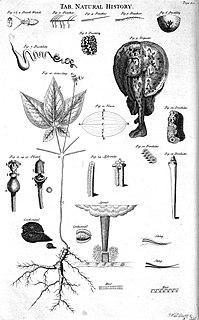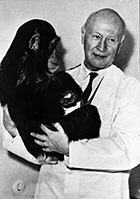Related Research Articles

Cladistics is an approach to biological classification in which organisms are categorized in groups ("clades") based on hypotheses of most recent common ancestry. The evidence for hypothesized relationships is typically shared derived characteristics (synapomorphies) that are not present in more distant groups and ancestors. Theoretically, a common ancestor and all its descendants are part of the clade. However, from an empirical perspective, common ancestors are inferences based on a cladistic hypothesis of relationships of taxa whose character states can be observed. Importantly, all descendants stay in their overarching ancestral clade. For example, if the terms worms or fishes were used within a strict cladistic framework, these terms would include humans. Many of these terms are normally used paraphyletically, outside of cladistics, e.g. as a 'grade'. Radiation results in the generation of new subclades by bifurcation, but in practice sexual hybridization may blur very closely related groupings.

Ernst Walter Mayr was one of the 20th century's leading evolutionary biologists. He was also a renowned taxonomist, tropical explorer, ornithologist, philosopher of biology, and historian of science. His work contributed to the conceptual revolution that led to the modern evolutionary synthesis of Mendelian genetics, systematics, and Darwinian evolution, and to the development of the biological species concept.

Biological systematics is the study of the diversification of living forms, both past and present, and the relationships among living things through time. Relationships are visualized as evolutionary trees. Phylogenies have two components: branching order and branch length. Phylogenetic trees of species and higher taxa are used to study the evolution of traits and the distribution of organisms (biogeography). Systematics, in other words, is used to understand the evolutionary history of life on Earth.

Emil Hans Willi Hennig was a German biologist who is considered the founder of phylogenetic systematics, also known as cladistics. In 1945 as a prisoner of war, Hennig began work on his theory of cladistics, which he published in German in 1950, with a substantially revised English translation published in 1966. With his works on evolution and systematics he revolutionised the view of the natural order of beings. As a taxonomist, he specialised in dipterans.

Natural history is a domain of inquiry involving organisms, including animals, fungi, and plants, in their natural environment, leaning more towards observational than experimental methods of study. A person who studies natural history is called a naturalist or natural historian.
The Zoological Society of London (ZSL) is a charity devoted to the worldwide conservation of animals and their habitats. It was founded in 1826.

George Ledyard Stebbins Jr. was an American botanist and geneticist who is widely regarded as one of the leading evolutionary biologists of the 20th century. Stebbins received his Ph.D. in botany from Harvard University in 1931. He went on to the University of California, Berkeley, where his work with E. B. Babcock on the genetic evolution of plant species, and his association with a group of evolutionary biologists known as the Bay Area Biosystematists, led him to develop a comprehensive synthesis of plant evolution incorporating genetics.

Bernhard Rensch was a German evolutionary biologist and ornithologist who did field work in Indonesia and India. Starting his scientific career with pro-Lamarckian views, he shifted to selectionism and became one of the architects of the modern synthesis in evolutionary biology, which he popularised in Germany. Besides his work on how environmental factors influenced the evolution of geographically isolated populations and on evolution above the species level, which contributed to the modern synthesis, he also worked extensively in the area of animal behavior (ethology) and on philosophical aspects of biological science. His education and scientific work were interrupted by service in the German military during both World War I and World War II.
The International Prize for Biology is an annual award for "outstanding contribution to the advancement of research in fundamental biology." The Prize, although it is not always awarded to a biologist, is one of the most prestigious honours a natural scientist can receive. There are no restrictions on the nationality of the recipient.
The Society for the Study of Evolution is a professional organization of evolutionary biologists. It was formed in the United States in 1946 to promote evolution and the integration of various fields of science concerned with evolution and to organize the publication of a scientific journal to report on new research on evolution across a variety of fields.
The species problem is the set of questions that arises when biologists attempt to define what a species is. Such a definition is called a species concept; there are at least 26 recognized species concepts. A species concept that works well for sexually reproducing organisms such as birds may be useless for species that reproduce asexually, such as bacteria. The scientific study of the species problem has been called microtaxonomy.
The Botanical Society of America (BSA) represents professional and amateur botanists, researchers, educators and students in over 80 countries of the world. It functions as a United States nonprofit 501(c)(3) membership society.
Anne Elizabeth Magurran is a British Professor of ecology at University of St Andrews in Scotland. She is the author of several books on measuring biological diversity, and the importance for quantifying biodiversity for conservation. She has won numerous awards and honors, is regularly consulted for global assessments and analyses of biodiversity and conservation and her research is often highlighted by journalists.
In biology, a species is the basic unit of classification and a taxonomic rank of an organism, as well as a unit of biodiversity. A species is often defined as the largest group of organisms in which any two individuals of the appropriate sexes or mating types can produce fertile offspring, typically by sexual reproduction. Other ways of defining species include their karyotype, DNA sequence, morphology, behaviour or ecological niche. In addition, paleontologists use the concept of the chronospecies since fossil reproduction cannot be examined.
The Willi Hennig Society "was founded in 1980 with the expressed purpose of promoting the field of phylogenetic systematics." The society is represented by phylogenetic systematists managing and publishing in the peer-reviewed journal titled Cladistics. The society is named after Willi Hennig, a German systematic entomologist who developed the modern methods and philosophical approach to systematics in the 1940s and 1950s. The society is also involved in reconstructing the tree of life. The current president, Ward Wheeler of the American Museum of Natural History, was elected in 2016, succeeding Dr. Jyrki Muona.
Alan Cooper is a New Zealand evolutionary molecular biologist and an ancient DNA researcher. He is considered a significant figure in the field of ancient DNA, and was involved in many of the early discoveries in the field. He was the inaugural director of both the Henry Wellcome Ancient Biomolecules Centre at the University of Oxford from 2001–2005, and the Australian Centre for Ancient DNA at the University of Adelaide, South Australia from 2005–2019. In December 2019, the University dismissed him, citing "serious misconduct".
Danielle "Hopi" Elizabeth Hoekstra is an evolutionary biologist working at Harvard University in Cambridge, Massachusetts. Her lab uses natural populations of rodents to study the genetic basis of adaptation. She is the Alexander Agassiz Professor of Zoology in the Department of Organismic and Evolutionary Biology and the Department of Molecular and Cellular Biology at Harvard University. She is also the Curator of Mammals at the Museum of Comparative Zoology and a Harvard College Professor. In 2014, Hoekstra became a Howard Hughes Medical Institute Investigator. In 2016, she was elected to the National Academy of Sciences, and in 2017, she was elected to the American Academy of Arts and Sciences.
Kevin de Queiroz is a vertebrate, evolutionary, and systematic biologist. He has worked in the phylogenetics and evolutionary biology of squamate reptiles, the development of a unified species concept and of a phylogenetic approach to biological nomenclature, and the philosophy of systematic biology.
Anne Daphne Yoder is an American biologist, researcher, and professor in the Department of Biology at Duke University in Durham, North Carolina, United States. Yoder's work includes the study, preservation, and conservation of the multifarious biodiversity found in Madagascar. One of her main research topics focuses on the diverse lemur population found on the island. Specifically, Yoder's research concentrates on assorted geographic factors that lead to varying levels of biological differences in the speciation process. Her investigations utilize genome research to further understand the complex and unique degree of speciation that occurs in lemur populations.

The scientific study of speciation — how species evolve to become new species — began around the time of Charles Darwin in the middle of the 19th century. Many naturalists at the time recognized the relationship between biogeography and the evolution of species. The 20th century saw the growth of the field of speciation, with major contributors such as Ernst Mayr researching and documenting species' geographic patterns and relationships. The field grew in prominence with the modern evolutionary synthesis in the early part of that century. Since then, research on speciation has expanded immensely.
References
- ↑ "Society of Systematic Biologists legal documents" (PDF). Society of Systematic Biologists. Retrieved August 3, 2012.
- ↑ "Society of Systematic Biologists governance". Society of Systematic Biologists. Retrieved August 3, 2012.
- ↑ "Society of Systematic Biologists: Constitution of the society of systematic biologists". Society of Systematic Biologists. Retrieved August 3, 2012.
- ↑ Claridge, M. F. (1995). "Primary Title: Introducing systematics Agenda 2000". Biodiversity and Conservation. 4 (5): 451–454. doi:10.1007/BF00056335.
- ↑ Butler, D.; Gee, H.; Macilwain, C. (1998). "Museum research comes off list of endangered species". Nature. 394 (6689): 115–117. doi:10.1038/28009.
- ↑ Daly, M.; Herendeen, P. S.; Guralnick, R. P.; Westneat, M. W.; McDade, L. (2012). "Systematics Agenda 2020: The Mission Evolves". Syst Biol. 61 (4): 549–552. doi:10.1093/sysbio/sys044. PMC 3376376 . PMID 22492540.
- 1 2 "Ernst Mayr Award". www.systbio.org. Retrieved 6 January 2021.